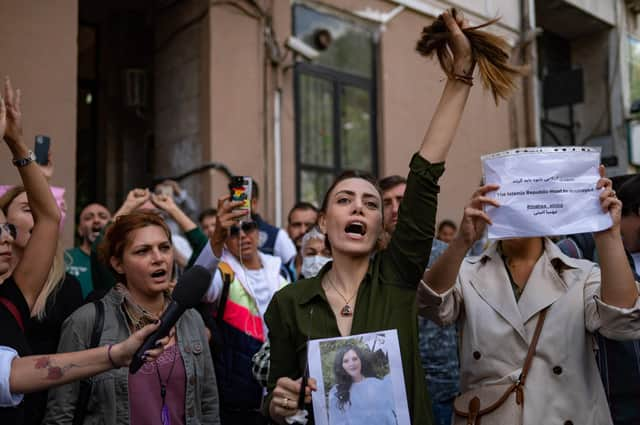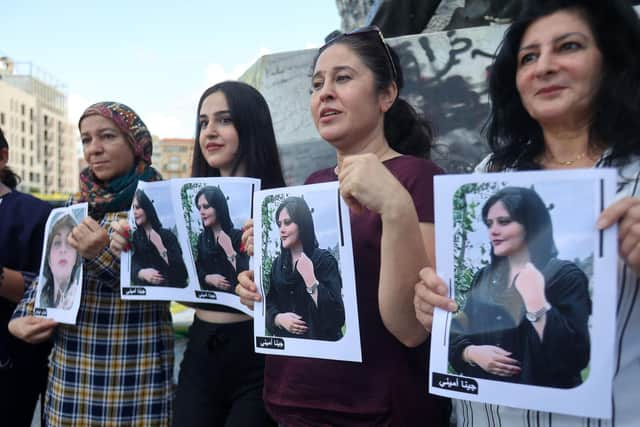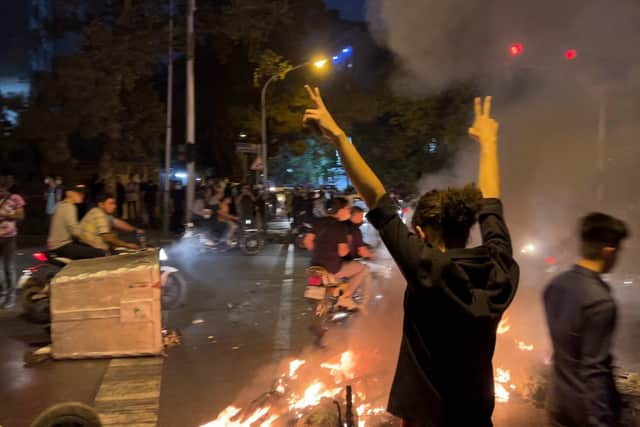Mahsa Amini: Iran's despotic mullahs rocked by mass protests after woman dies in custody of 'morality police' – Struan Stevenson


Amini was beaten to death by the mullahs’ morality police after she was detained in Tehran on 13 September for failing to comply with the regime’s strict hijab rules.
Women in Iran have been treated as second-class citizens by the mullahs for more than four decades. The misogynist lunacy of the clerical regime has even extended to a demand by Supreme Leader Ayatollah Ali Khamenei that women depicted in cartoons must wear a headscarf. Now, in Iran, even female animated characters cannot reveal their hair.
Advertisement
Hide AdAdvertisement
Hide AdWomen’s dress codes are under constant scrutiny. They must wear the hijab and ‘morality police’ are on relentless patrol to enforce the law.
Women, particularly young women, are singled out for brutal attacks for the ‘crime’ of ‘mal-veiling’. Girls deemed to be improperly dressed in the street have suffered horrific acid attacks and stabbings, in assaults openly condoned by the mullahs.
Teenage girls, arrested for the offence of posting videos of themselves dancing or singing on social media, have been publicly flogged. Young female students attending end-of-term parties have been fined and beaten. This is what gender equality looks like in Iran today.
The toll of women executed in Iran’s medieval prisons continues to rise. Most of these women were executed for killing an abusive husband or partner.
But this is another example of how the regime fails women, because they are mostly victims of domestic abuse who kill in defence of themselves or their children, because they have no legal recourse to end a violently cruel marriage.


These killings often occur after women have suffered years of humiliation, insults, beatings and even torture by abusive husbands, from whom they have no escape, no right to divorce.
In other countries, they would be granted leniency based on their circumstances, but not in Iran. And this, of course, does not even touch upon those executed for crimes that are not capital offences under international law, like drug offences, or for non-crimes, like political activism.
There are approximately 40 million women in the Islamic Republic of Iran, more than half under the age of 30. Women make up more than 50 per cent of university students, but, because of discrimination and blatant sexism creating obstacles to employment, they account for only 19 per cent of Iran’s workforce.


Advertisement
Hide AdAdvertisement
Hide AdAt a time when women in the West have achieved political, economic, personal and social equality, Iranian women are amongst the most repressed in the world, ruled by a regime dominated by elderly, bearded misogynists.
But young Iranian women are becoming increasingly engaged in the growing opposition to the mullahs’ corrupt regime.
They are joining resistance units that are springing up in every town and city in Iran. In the nationwide uprisings that have taken place, thousands of courageous female teachers, medical staff, nurses, students, factory workers and pensioners have taken to the streets to demand an end to corruption, an end to discrimination and repression and an end to the clerical regime’s aggressive military adventurism across the Middle East.
In protests in the past five years, hundreds of women have been amongst those killed by the Islamic Revolutionary Guards Corps (IRGC) and thousands more have been arrested.


Following the death of Mahsa Amini last week, hundreds of women have been seen in mass rallies tearing off and setting fire to their hijabs while chanting “death to the dictator".
In the theocratic fascist dictatorship, the Iranian penal code is designed to enable men to discipline women and girls if they fail to conform to strict Islamic codes.
The theocratic dictatorship in Iran has a history of targeting women with oppressive laws that would not be tolerated in the West or indeed in most civilized countries in the world.
In Iran, women are considered the property of their closest male relative and have no legal rights. Girls of nine can be married off by their parents. A woman’s evidence in court is worth only half that of a man.
Advertisement
Hide AdAdvertisement
Hide AdWomen may not seek to have a man charged with rape unless they have four independent witnesses. All family relationships are strictly controlled by Sharia law. Homosexual behaviour, adultery, and sex outside marriage are all prohibited. Women accused of such behaviour can incur severe punishments, including beatings and death, sometimes by stoning.
Ayatollah Ruhollah Khomeini, the first Supreme Leader of Iran after the 1979 revolution and the father of Islamic fundamentalism, stated that equality between women and men was “in fundamental violation of some of the most crucial rulings of Islam and in defiance of some of the explicit commandments of the Quran”.
Immediately following the revolution, Khomeini abolished a family protection law that gave women family rights. He also cancelled social services for women and abolished the role of female judges in Iran’s justice system. Today, only a tiny minority of MPs in Iran are women.
However, Iranian women are now at the forefront of the resistance to the theocratic dictatorship. Indeed, the main democratic opposition movement, the PMOI/MEK is led by a woman, the charismatic Maryam Rajavi.
Brave women are now routinely joining their brothers to demand regime change and an end to the misogyny and repression which has terrorised the Iranian people for the past four decades.
The murder of Mahsa Amini by the morality police may be the last straw. It may be the spark that ignites the revolution which will sweep the turbaned tyrants in Iran from power.
Struan Stevenson, a former member of the European Parliament for Scotland, is the coordinator of the Campaign for Iran Change, chair of the In Search of Justice committee on the protection of political freedoms in Iran, an international lecturer on the Middle East and president of the European Iraqi Freedom Association
Comments
Want to join the conversation? Please or to comment on this article.
